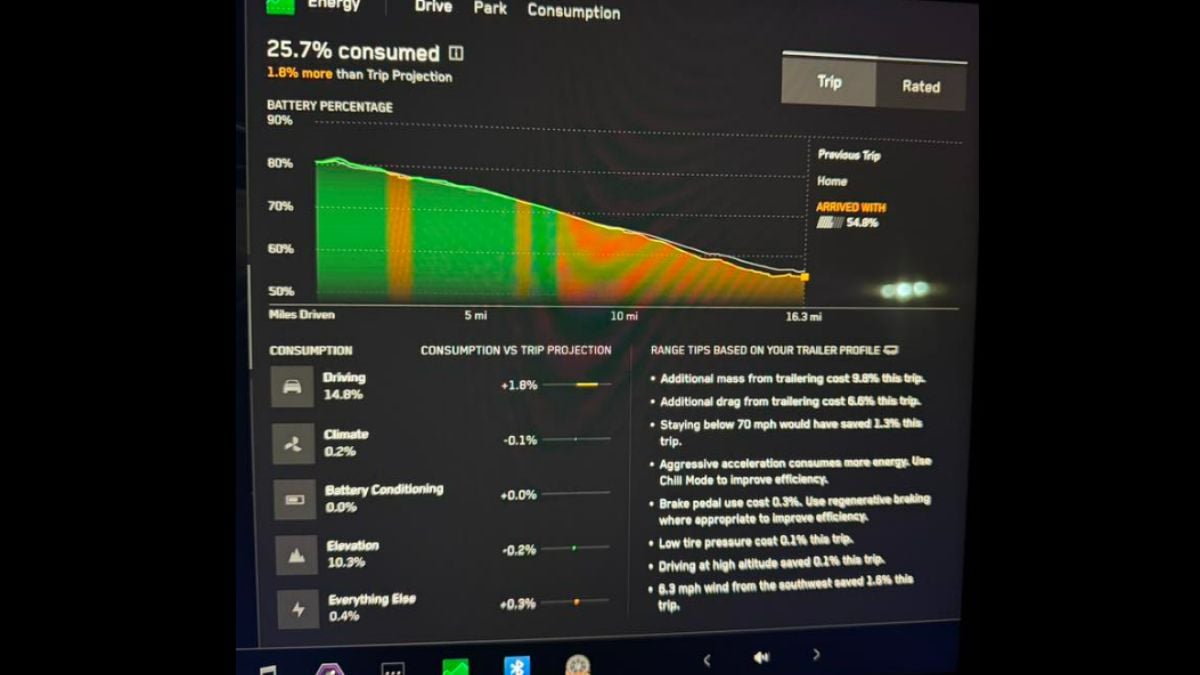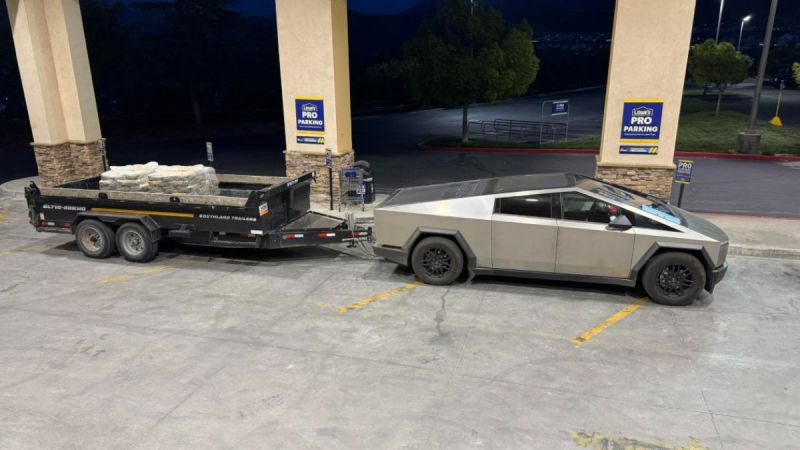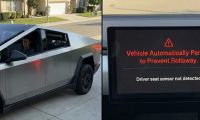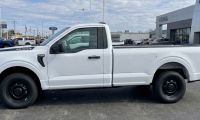Towing is one of those real-world tests that quickly separates hype from hardware, and it’s where a lot of owners are still looking for proof when it comes to electric trucks. That’s why a recent post by Riley Bowers in the “Cybertruck Owners Only” Facebook group stood out to me this morning. Riley had just towed a trailer for the first time with his Tesla Cybertruck, pulling a combined 7,500 pounds up a steep mountain climb from 1,200 to 4,000 feet. While the truck’s electric power delivery was strong making it feel like the trailer wasn’t even back there, Riley noticed just enough lateral sway to consider investing in a weight-distribution or sway-control hitch. Riley shared their experience in a brief but detailed post:
“First trailer I’ve towed with it. 7,500 lbs in the trailer, and the trailer probably weighs around 3,000-4,000 lbs. It was a 1,200’ to 4,000’ elevation climb. As far as available power, it was as if I didn’t even have the trailer. It was lateral stability where it was most noticeable. Not that it was exactly ‘squirrelly’ but it could probably benefit from a weight distributing/sway control hitch. Energy consumption was about double what the truck uses empty on the same drive. And I wasn’t easy on it by any means.”
Effortless Power Meets Real-World Resistance
One of the more consistent praises for the Tesla Cybertruck has been its instant torque and electric power delivery. This experience from Riley lines up with other real-world towing reports, like one where the Cybertruck hauled a 7,000-pound camper through beach traffic. This shows how confident the vehicle feels under stress, because climbing from 1,200 to 4,000 feet without breaking a sweat is impressive, especially considering the weight being pulled.
That said, no towing test is complete without discussing balance and control. Lateral sway is a common concern when trailers are loaded unevenly or when the hitch setup lacks additional sway control features. In Riley’s case, the truck handled the power and incline just fine, but the road feedback, especially in curves or gusty wind sections, reminded him that raw power doesn’t equal total control.

Community Weighs In
Several commenters chimed in to offer feedback and share insights. Greg Aguglia had one of the more detailed takes, suggesting that the issue wasn’t the truck itself:
“It is loaded to the rear too far which accounts for the sway. (2' to the R behind the load, 5' to the F in front of the load). You need enough tongue weight for stability. Had you axled out the truck & trailer prior to loading, then again post loading, I'm sure there would be minimal change in the rear axle weight of the truck. It isn't the truck, it's the operator.”
Greg’s comment is a great reminder that even the most advanced trucks can’t override physics. Weight distribution and proper hitch setup remain just as important as ever, even if your truck looks like it came straight out of the future.
Mike Dep expanded the conversation toward energy usage:
“An open trailer isn't the worst range killer. It’s the same weight in a cargo trailer, V-neck or not, and it would have to cost significantly more. The constant wind resistance is what affects range the most. Highway speed range with a cargo trailer is bad.”
Mike’s insight helps explain why Riley saw energy usage double during the climb, but Riley did admit that he was hard on the gas anyway. The Cybertruck, like most EVs, isn’t immune to aerodynamics, and once you hit highway speeds with an open or poorly shaped trailer, your efficiency can drop rapidly. This aligns with broader coverage around the Cybertruck’s performance and resale market, showing that real-world usage often paints a clearer picture than spec sheets.
Then there was Grant Hamilton's comment, who kept it simple: “It tows great.” Grant also shared a picture in his comment showing his Cybertruck hitched up. And honestly, that one-liner speaks to what many owners are experiencing. Tesla’s all-electric truck may still have kinks, but when it comes to the towing ability, it delivers for a lot of owners.

Tesla’s Hardware Is Ready, But the Experience Still Matters
The Cybertruck’s towing capacity is ready for a lot of real world application, and they also recently made more improvements by adjusting the factory hitch setup, which now includes a high-strength Class IV steel system. It’s rated to tow up to 11,000 lbs depending on configuration. But even with the right hardware, a smooth tow still depends on thoughtful prep and smart technique. Riley’s story shows that brute strength is only part of the equation, and what you do with that strength is where the challenge really begins.
Also worth noting is the growing shift in how Tesla is handling Cybertruck ownership more broadly. From offering trade-in programs that reveal steep early depreciation to first-time reviews by new buyers, the Cybertruck is still under a microscope. Stories like Riley’s show it’s got serious muscle, but the platform is still evolving as more owners take it into the real world.
I think what makes his story so compelling isn’t just how well the Cybertruck performed, but how it shows the shift we’re in right now. It's not just a question of asking whether electric trucks can tow. What we’re figuring out now is how to optimize them for real-world conditions. Obviously I'm not saying it can compare to the towing capacity of a Chevy Silverado 3500HD, as an example, but it is impressive how far we have come with EV's.
Tesla has delivered the torque and capability, but owners still have to learn the same lessons they would with an gas/diesel truck: distribute weight properly, understand trailer dynamics, and respect the impact of aerodynamics. This is the kind of real-world feedback that helps shape the future of EV towing. And honestly, I think it’s only going to get better from here.
Key Takeaways
Effortless Power: The Cybertruck delivers massive torque even with a heavy trailer, showing just how capable its drivetrain is.
Towing Setup Still Matters: Tesla may have engineered an impressive platform, but as early owner impressions show, driver technique, hitch configuration, and weight balance remain key.
Efficiency Drops Are Normal: Just like gas/diesel trucks guzzle fuel under load, EVs experience steep consumption when towing, especially on elevation climbs and highways.
Learning Curve for New EV Truck Owners: The Cybertruck proves it has the strength to pull, but using that power effectively still requires traditional towing knowledge. This transition to electric power doesn’t eliminate the basics.
What Are Your Thoughts?
Do you think the Cybertruck will be capable of more towing capacity in the future?
And if you own one, how has your experience with range and stability been?
Your insight reflects what many others might be thinking, so don't hesitate to share in the comments below.
Aram Krajekian is a young automotive journalist bringing a fresh perspective to his coverage of the evolving automotive landscape. Follow Aram on X and LinkedIn for daily news coverage about cars.
Image Sources: The “Cybertruck Owners Only” public Facebook group.











